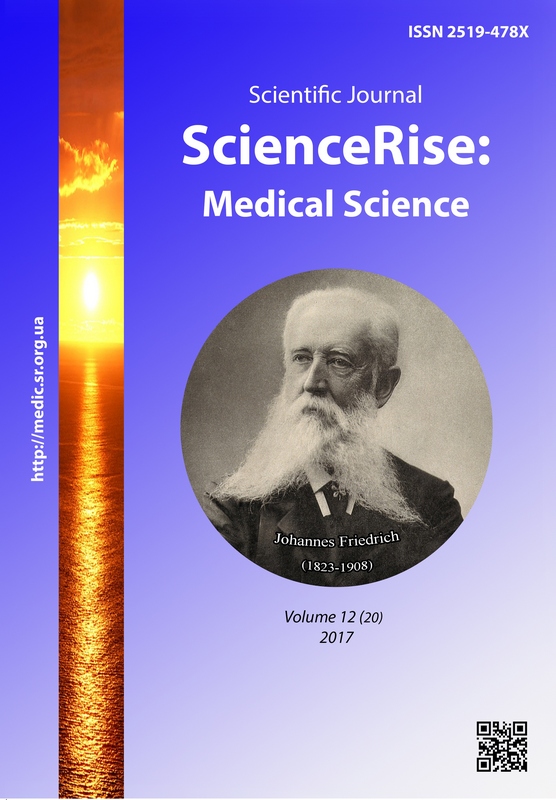Life quality level as a target of art-therapeutic influence in the complex treatment of patients with schizophrenia
DOI:
https://doi.org/10.15587/2519-4798.2017.118987Keywords:
art-therapy, patients with schizophrenia, social functioning, positive, negative, general psychopathological syndromesAbstract
Aim: to study the life quality dynamics of patients with schizophrenia under the influence of art-therapy in the system of therapy and rehabilitation.
Materials and methods: At the research there was realized the complex clinical-psychopathological examination of 125patients of both sexes, 20–45years old (mean age 35,0±2,0 years) with the set diagnosis schizophrenia in the period of stabilization. The main group (participated in art-therapy) included 95 persons (54 women and 41 men). The control group consisted of 30 patients (16 women and 14 men), who received the standard regulated treatment at hospital.
Results of research. At the research there was used the system of art-therapy in the complex therapy of patients with schizophrenia and its effectiveness was proved.
On the background of the complex therapy including art-therapy, there was observed the fast reduction of the psychopathological symptomatology, normalization of the emotional condition, stabilization of patients’ behavior, improvement of cognitive indices, increase of patients’ psychophysical activity.
It was established, that on the background of using art-therapy in the complex treatment of patients with schizophrenia, the life quality index increased by all scales in the main group by 42,4 %, compared with the control– 26,9 %.
Conclusions. Under the influence of art-therapy in the complex treatment of schizophrenia there was observed the fast reduction of psychopathological symptomatology, increase of the duration and quality of remission.
There was established the high effectiveness of art-therapy compared with the traditional complex treatment as to improving the life quality of patients with schizophrenia.
Art-therapy, based on elaborated principles for patients with schizophrenia is characterized by the higher effectiveness, compared with traditionally used methods
References
- Kolyadko, S. P., Kalenska, G. Yu. (2017). Features of the use of art therapy in the treatment of patients with paranoid schizophrenia. Ukrainian Journal of Psychoneurology, 25 (1 (90)), 51–55.
- Dyhtyar, V. O. (2009). The level of social functioning and quality of life as the basis of psychotherapy for patients with paranoid schizo-freesia. Ukrainian Journal of Psychoneurology, 17 (3 (60)), 35–44.
- Kozhina, A. M., Gaychuk, L. M. (2010). Experience in using Soleron in the treatment of schizophrenia. Ukrainian Journal of Psychoneurology, 18 (4 (65)), 116–117.
- Podkorytov, V. S. (2008). Psychiatry in Ukraine – Past, Present, Future. Journal of Psychiatry and Psychopharmacotherapy, 2 (14), 29–32.
- Maruta, N. A. (2011). State of Provision and Prospects for the Development of Psychiatric Care in Ukraine. Archive of Psychiatry, 17 (3 (66)), 5–9.
- Voloshin, P. V., Maruta, N. O. (2015). Mental Health Protection Strategy of the Ukrainian Population: Contemporary Opportunities and Obstacles. Ukrainian Journal of Psychoneurology, 23 (1 (82)), 5–11.
- The state of mental health and psychiatric care in Ukraine (informational and analytical review for 2001 – 2010) (2011). Kyiv-Kharkiv, 173.
- Pushuk, N. G. (2010). Predictors of the process of psychosocial rehabilitation of the mentally ill. Ukrainian Journal of Psychoneurology, 18 (3 (64)), 145.
- Gumenyuk, L. N., Mikhailova, E. A. (2010). Art therapy in the system of complex psychosocial rehabilitation of schizophrenic patients in conditions of compulsory treatment. Tauric medico-biological Journal, 4, 37–40.
- Korostiy, V., Hmain, S. (2015). Art-therapy in Complex Treatment of Major Depressive Disorder. European Psychiatry, 30, 1324. doi: 10.1016/s0924-9338(15)31033-6
- Hmain, S. (2015). Effectiveness of art therapy in complex treatment of patients with depressive recurrent disorder. Berlin: Deutsche Gesellschaft für Psychiatrie und Psychotherapie, Psychosomatik und Nervenheilkunde Kongress, 12-004.
Downloads
Published
How to Cite
Issue
Section
License
Copyright (c) 2017 Alexandr Krishtal

This work is licensed under a Creative Commons Attribution 4.0 International License.
Our journal abides by the Creative Commons CC BY copyright rights and permissions for open access journals.
Authors, who are published in this journal, agree to the following conditions:
1. The authors reserve the right to authorship of the work and pass the first publication right of this work to the journal under the terms of a Creative Commons CC BY, which allows others to freely distribute the published research with the obligatory reference to the authors of the original work and the first publication of the work in this journal.
2. The authors have the right to conclude separate supplement agreements that relate to non-exclusive work distribution in the form in which it has been published by the journal (for example, to upload the work to the online storage of the journal or publish it as part of a monograph), provided that the reference to the first publication of the work in this journal is included.









